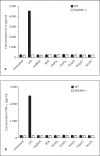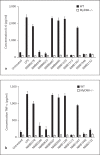SR-A, MARCO and TLRs differentially recognise selected surface proteins from Neisseria meningitidis: an example of fine specificity in microbial ligand recognition by innate immune receptors
- PMID: 20375573
- PMCID: PMC7312862
- DOI: 10.1159/000155227
SR-A, MARCO and TLRs differentially recognise selected surface proteins from Neisseria meningitidis: an example of fine specificity in microbial ligand recognition by innate immune receptors
Abstract
Macrophages express various classes of pattern recognition receptors involved in innate immune recognition of artificial, microbial and host-derived ligands. These include the scavenger receptors (SRs), which are important for phagocytosis, and the Toll-like receptors (TLRs) involved in microbe sensing. The class A macrophage scavenger receptor (SR-A) and macrophage receptor with a collagenous structure (MARCO) display similar domain structures and ligand-binding specificity, which has led to the assumption that these two receptors may be functionally redundant. In this study we show that SR-A and MARCO differentially recognise artificial polyanionic ligands as well as surface proteins from the pathogenic bacterium Neisseria meningitidis. We show that, while acetylated low-density lipoprotein (AcLDL) is a strong ligand for SR-A, it is not a ligand for MARCO. Of the neisserial proteins that were SR ligands, some were ligands for both receptors, while other proteins were only recognised by either SR-A or MARCO. We also analysed the potential of these ligands to act as TLR agonists and assessed the requirement for SR-A and MARCO in pro-inflammatory cytokine induction. SR ligation alone did not induce cytokine production; however, for proteins that were both SR and TLR ligands, the SRs were required for full activation of TLR pathways.
Copyright 2008 S. Karger AG, Basel.
Figures





Similar articles
-
MARCO, an innate activation marker of macrophages, is a class A scavenger receptor for Neisseria meningitidis.Eur J Immunol. 2006 Apr;36(4):940-9. doi: 10.1002/eji.200535389. Eur J Immunol. 2006. PMID: 16525990
-
SR-A/MARCO-mediated ligand delivery enhances intracellular TLR and NLR function, but ligand scavenging from cell surface limits TLR4 response to pathogens.Blood. 2011 Jan 27;117(4):1319-28. doi: 10.1182/blood-2010-03-276733. Epub 2010 Nov 23. Blood. 2011. PMID: 21098741
-
Activation of murine macrophages by Neisseria meningitidis and IFN-gamma in vitro: distinct roles of class A scavenger and Toll-like pattern recognition receptors in selective modulation of surface phenotype.J Leukoc Biol. 2004 Sep;76(3):577-84. doi: 10.1189/jlb.0104014. Epub 2004 Jun 24. J Leukoc Biol. 2004. PMID: 15218052
-
[The role of the class A scavenger receptors, SR-A and MARCO, in the immune system. Part 2. Contribution to recognition and phagocytosis of pathogens as well as induction of immune response].Postepy Hig Med Dosw (Online). 2012 Feb 29;66:120-31. doi: 10.5604/17322693.984080. Postepy Hig Med Dosw (Online). 2012. PMID: 22470186 Review. Polish.
-
[The role of the class A scavenger receptors, SR-A and MARCO, in the immune system. Part 1. The structure of receptors, their ligand binding repertoires and ability to initiate intracellular signaling].Postepy Hig Med Dosw (Online). 2012 Feb 29;66:104-19. doi: 10.5604/17322693.984079. Postepy Hig Med Dosw (Online). 2012. PMID: 22470185 Review. Polish.
Cited by
-
Bone marrow-derived and resident liver macrophages display unique transcriptomic signatures but similar biological functions.J Hepatol. 2016 Oct;65(4):758-768. doi: 10.1016/j.jhep.2016.05.037. Epub 2016 Jun 1. J Hepatol. 2016. PMID: 27262757 Free PMC article.
-
The Evolution of the Scavenger Receptor Cysteine-Rich Domain of the Class A Scavenger Receptors.Front Immunol. 2015 Jul 6;6:342. doi: 10.3389/fimmu.2015.00342. eCollection 2015. Front Immunol. 2015. PMID: 26217337 Free PMC article.
-
The Sponge Hologenome.mBio. 2016 Apr 21;7(2):e00135-16. doi: 10.1128/mBio.00135-16. mBio. 2016. PMID: 27103626 Free PMC article. Review.
-
Innate immune functions of macrophage subpopulations in the spleen.J Innate Immun. 2012;4(5-6):437-45. doi: 10.1159/000335216. Epub 2012 Feb 7. J Innate Immun. 2012. PMID: 22327291 Free PMC article. Review.
-
Galectin-3 binds Neisseria meningitidis and increases interaction with phagocytic cells.Cell Microbiol. 2012 Nov;14(11):1657-75. doi: 10.1111/j.1462-5822.2012.01838.x. Epub 2012 Aug 12. Cell Microbiol. 2012. PMID: 22827322 Free PMC article.
References
-
- Akira S, Uematsu S, Takeuchi O. Pathogen recognition and innate immunity. Cell. 2006;124:783–801. - PubMed
-
- Gordon S. Pattern recognition receptors: doubling up for the innate immune response. Cell. 2002;111:927–930. - PubMed
-
- Taylor PR, Martinez-Pomares L, Stacey M, Lin H-H, Brown GD, Gordon S. Macrophage receptors and immune recognition. Annu Rev Immunol. 2005;23:901–944. - PubMed
-
- O'Neill LA. How Toll-like receptors signal: what we know and what we don't know. Curr Opin Immunol. 2006;18:3–9. - PubMed
-
- Krieger M. The other side of scavenger receptors: pattern recognition for host defense. Curr Opin Lipidol. 1997;8:275–280. - PubMed
Publication types
MeSH terms
Substances
Grants and funding
LinkOut - more resources
Full Text Sources
Medical
Research Materials
Miscellaneous

